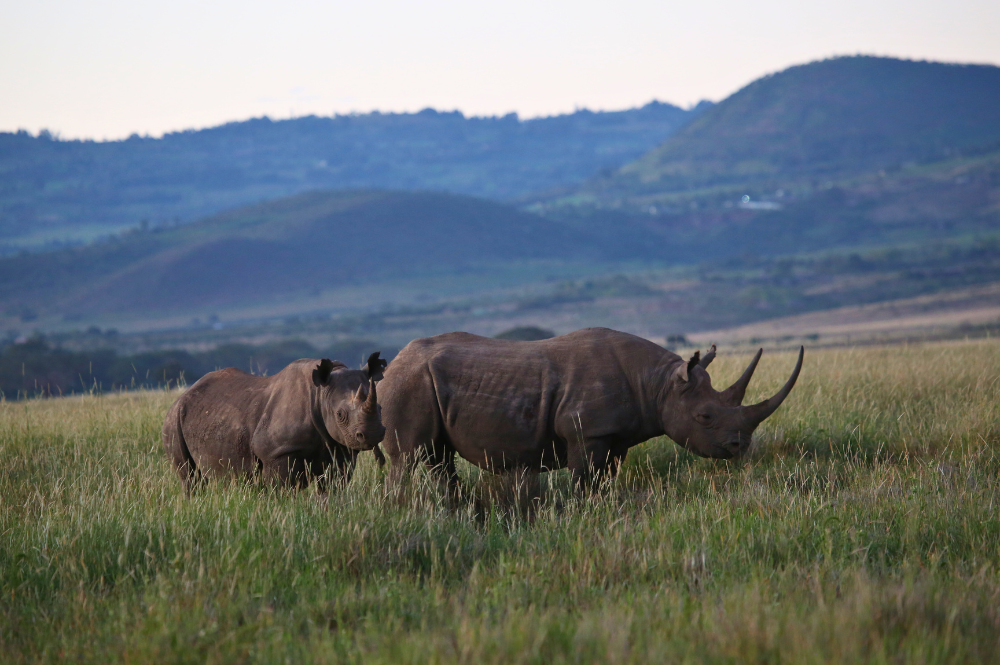The Kenya Wildlife Service (KWS) and partners recently finalised the creation of a new black rhino population on Loisaba Conservancy after re-introducing 21 Eastern black rhinos from three reserves across Kenya. The operation, which successfully translocated rhinos from Ol Pejeta Conservancy, Lewa Wildlife Conservancy and Nairobi National Park, is part of the National Rhino Range Expansion project which aims to secure more space to enable Kenya’s black rhino population to continue to grow and bring benefits across the country.
Kenya’s black rhino population has more than doubled since 1989, and recently exceeded 1,000 individuals. Hitting this exciting milestone has required continued dedication and collaboration by many partners, including Government, community, private sector and NGO groups, to protect and support black rhinos across the country. However, with a long-term goal to double this number again and reach 2,000 black rhinos in Kenya, identifying and securing more space for rhinos and ensuring benefits to people living around wildlife is key.
Loisaba Conservancy covers 58,000-acres in Laikipia County, Northern Kenya, an area that’s become renowned as a stronghold for the Eastern black rhino. Despite the challenges of poaching and drought, and thanks to constant monitoring and protection, the overall number of black rhinos in Laikipia has grown successfully over time. However, once a rhino population reaches a certain size, it becomes limited by the amount of resources available in the habitat throughout the year, in terms of food, water and space. When this level is reached, the number of calves being born into the population declines and fighting between rhinos can increase, stalling growth and sometimes even decreasing the total population. Therefore, expanding the range available to rhinos is crucial to ensure their numbers continue to rise. KWS, through Kenya’s Black Rhino Action Plan, aims to have the national black rhino population increase by 5% annually.
The National Rhino Range Expansion project for Kenya, championed by the Association of Private and community Land Rhino Sanctuaries (APLRS), is key to finding more space for rhinos. In September 2019, Save the Rhino joined APLRS members, KWS and experts from across Africa at a workshop to catalyse rhino range expansion in Laikipia. The workshop explored potential new sites for rhinos and produced criteria to assess site suitability. Since then, thanks to funding through public donors, the US Government’s Bureau of International Narcotics and Law Enforcement, and the US Fish and Wildlife Service, our field partners have continued to protect, support and monitor their key rhino populations, providing the opportunity for animals from these reserves to now be relocated to create the new population in Loisaba.
Of course, moving rhinos isn’t a simple task. The translocation exercise, led by KWS, has involved a wide range of partners, and taken years of planning and months of preparation, including assessing habitat suitability, developing infrastructure and security improvements on Loisaba. A mix of healthy females and males were selected by experts in advance, giving the rhinos the best chance for future success in their new home.
Our CEO, Dr Jo Shaw, joined some of the rhino captures on Lewa Wildlife Conservancy and releases on Loisaba Conservancy and says,
“We congratulate KWS and partners on the successful completion of this important translocation. Bringing rhinos back to Loisaba Conservancy is a key step forward in achieving the goal of continued growth of Kenya’s black rhino population through expansion of rhino range. Operations of this scale and complexity can only work through effective partnerships – and bode well for plans for National Rhino Range Expansion across Kenya.”
As the rhinos now settle into their new home, rhino monitors and rangers will be looking over them 24/7 to make sure they are finding their feet and settle in well. With constant support, there may even be the pitter-patter of little rhinos sometime soon!









